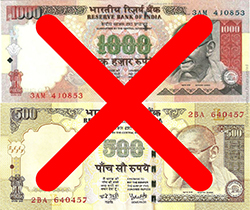India’s Progress under Prime Minister Modi
 |
|
|
PM Modi brought in what is termed as the biggest tax reform in the country since post-independence on July 1. Goods & Services Tax is a comprehensive, multi-stage, destination-based indirect tax levied on every value addition such as the supply of goods and services.
|
|
| The Indian economy has witnessed ambitious growth over the last three years. According to the World Investment Report, India is among the top three prospective host economies of the world. In the last fiscal year, the country garnered investments worth $55 billion.
Economic reforms of the Union government including inflation control, fiscal deficit, trade deficit, ease of doing business, manufacturing revival seem to have delivered. |
|
| Demonetization
|
GST
|
| Sixth Largest Manufacturing Nation
As per the Global Competitive Index of the World Economic Forum, India has jumped 32 places and is the 6th largest manufacturing nation in the world. Prime Minister Narendra Modi as part of his personal initiative has fast-tracked projects worth Rs. 8 lakh crore that was long pending. |
New Projects Launched Nearly 30 new projects have been launched in the last three years. These include Digital India, GST, Swachh Bharat, Make in India, Smart City, Startup India, Jan Dhan, Skill India, Udaan Scheme, Crop Insurance Scheme, GiveItUp LPG Subsidy, National Health Policy and many more. |
| Jan-Dhan Scheme
|
PM Ujjwala Scheme
|
|
Affordable Housing The PM launched Pradhan Mantri Gramin Awas Yojna with the aim of providing ‘Housing for All’ by 2022. The scheme is designed for the rural masses. |
Commitment to Renewable Energy
India has produced 50 GW of renewable energy in the last three years; however, the government has plans to produce 175 GW in keeping with its commitment towards production and use of clean energy. |
|
With nearly 22 crores LED bulbs distributed by the government, around Rs. 11,000 crore in electricity bills have been saved. India ranks 4th in the world in global wind power installed capacity.
|
|
| Electricity Saving
Pew Research Center conducted a survey among 2,464 respondents in India from February 21 to March 10, 2017. Nine out of 10 Indians hold a favorable opinion of Modi, compared to their view of him in 2015. About seven out of 10 have a very favorable view of the prime minister, similar to views in 2015, PEW Global Center stated in its report. PM Modi remains the most popular figure in Indian politics according to the survey. His favorable rating is 31 percent higher than that of Sonia Gandhi and is 30 points more than that of Rahul Gandhi. The government of India’s local and foreign currency issuer ratings have been upgraded by Moody’s Investors Service to Baa2 from Baa3 and changed the outlook on the rating to stable. Moody’s has also upgraded India’s local currency senior unsecured rating to Baa2 from Baa3 and its short-term local currency rating to P-2 from P-3, according to The Economic Times. Due to the Union government’s various economic and institutional reform programs those that have been implemented will improve the business climate, enhance productivity, stimulate foreign and domestic investment, and ultimately foster strong and sustainable growth. Moody’s expects real GDP growth to moderate to 6.7 percent in the fiscal year ending in March 2018 (FY2017) and real GDP to rise to 7.5 percent in FY2018. Overall India is in a strong position with its economy, robust economic growth, strong fiscal consolidation, low current account deficit, higher agricultural output, growing FDI, low inflation, and higher wages in rural areas, a World Bank report released in May 2017 stated. |
|



 On November 8, 2016, Prime Minister Narendra Modi demonetized large currency notes. To root out black money and fake currency notes, he scrapped old Rs.500 and Rs.1000 notes. This step was termed ‘the single most economic reform in the history of independent India’ according to
On November 8, 2016, Prime Minister Narendra Modi demonetized large currency notes. To root out black money and fake currency notes, he scrapped old Rs.500 and Rs.1000 notes. This step was termed ‘the single most economic reform in the history of independent India’ according to PM Modi brought in what is termed as the biggest tax reform in the country since post-independence on July 1. Goods & Services Tax is a comprehensive, multi-stage,
PM Modi brought in what is termed as the biggest tax reform in the country since post-independence on July 1. Goods & Services Tax is a comprehensive, multi-stage,  In a bid for financial inclusion, PM Modi launched his first flagship program — Pradhan Mantri Jan-Dhan Yojana in August 2014. The national mission ensures use of financial services such as savings accounts, remittance, credit, insurance and pension in an affordable manner. Modi brought the country’s over 15 percent population under the scheme, now over 27.84 crore accounts have been opened under the scheme. This economic policy helped him to gain popularity as a leader of the masses.
In a bid for financial inclusion, PM Modi launched his first flagship program — Pradhan Mantri Jan-Dhan Yojana in August 2014. The national mission ensures use of financial services such as savings accounts, remittance, credit, insurance and pension in an affordable manner. Modi brought the country’s over 15 percent population under the scheme, now over 27.84 crore accounts have been opened under the scheme. This economic policy helped him to gain popularity as a leader of the masses.
 With nearly 22 crores LED bulbs distributed by the government, around Rs. 11,000 crore in electricity bills have been saved. India ranks 4th in the world in global wind power installed capacity. The government is consciously taking grassroots level steps to strengthen the common man and the rural foundations. It is not only targeting mega projects but is also paying equal attention to micro-level social engineering.
With nearly 22 crores LED bulbs distributed by the government, around Rs. 11,000 crore in electricity bills have been saved. India ranks 4th in the world in global wind power installed capacity. The government is consciously taking grassroots level steps to strengthen the common man and the rural foundations. It is not only targeting mega projects but is also paying equal attention to micro-level social engineering.



























